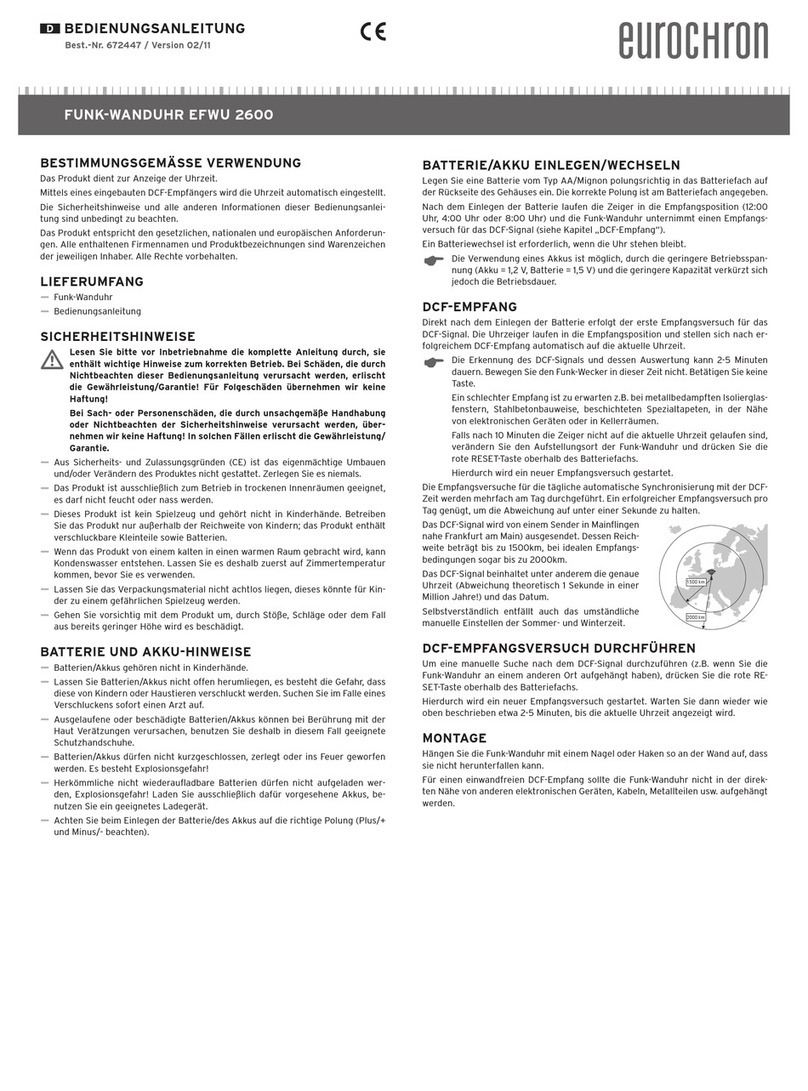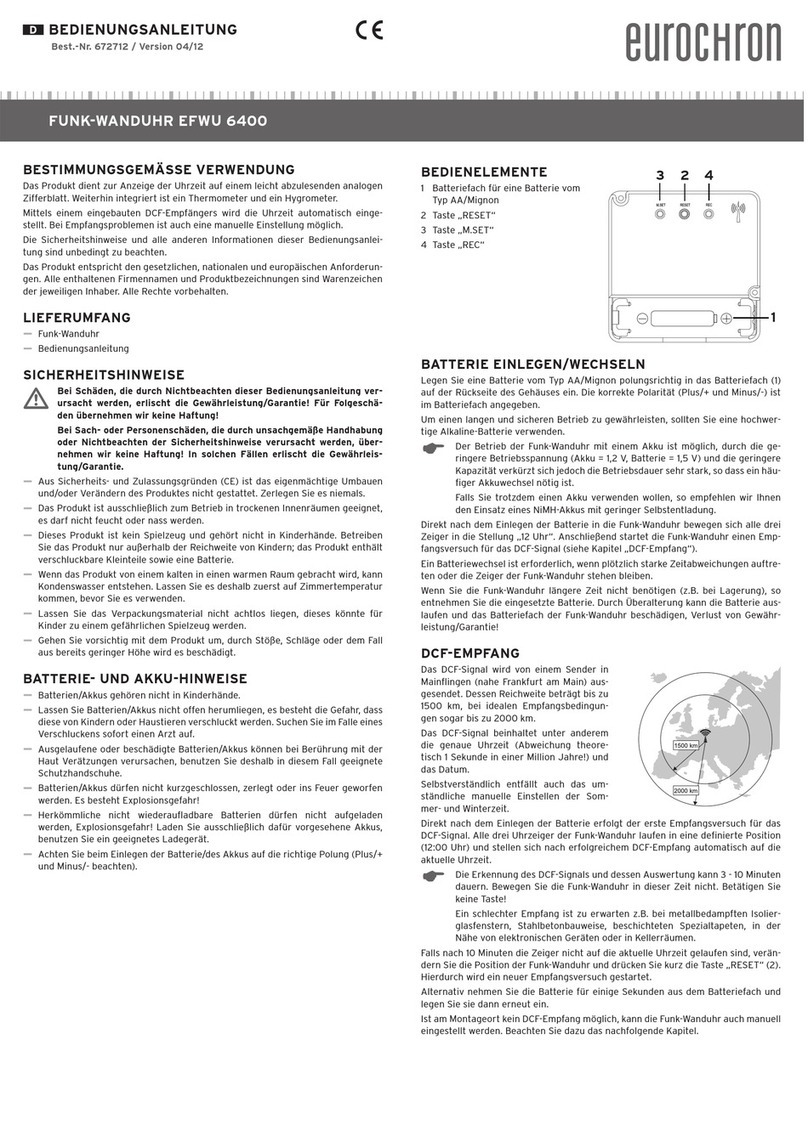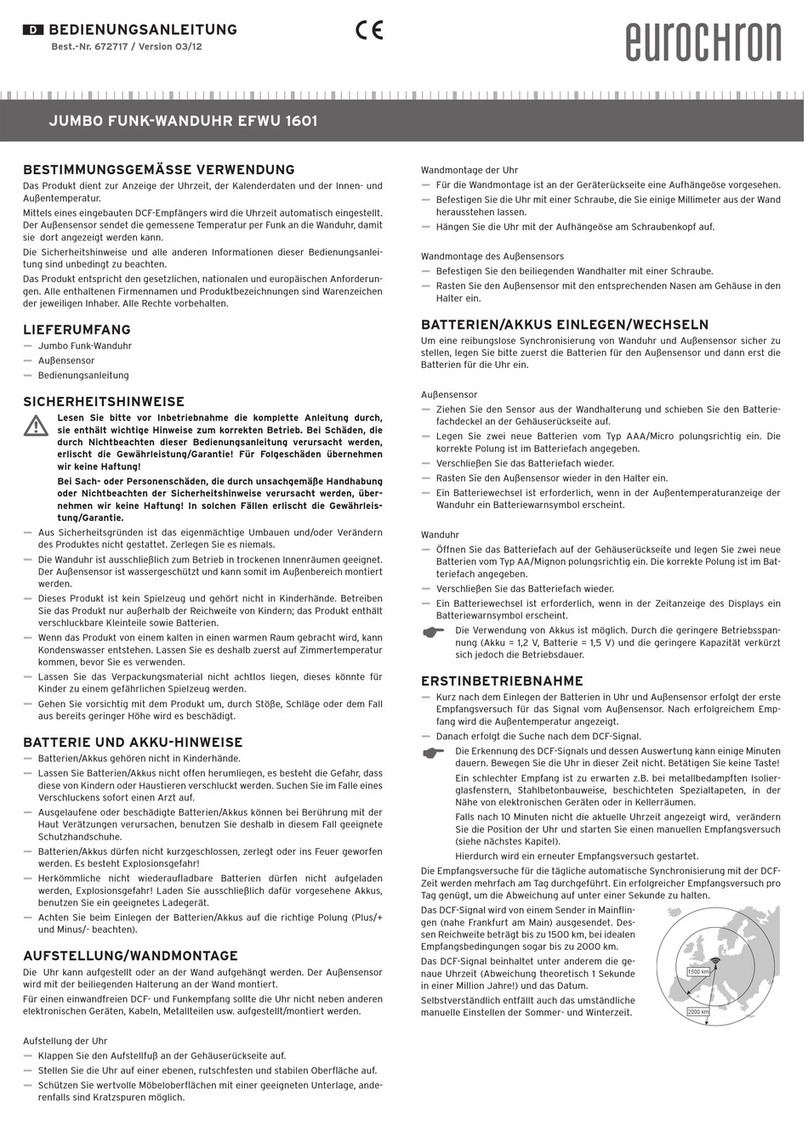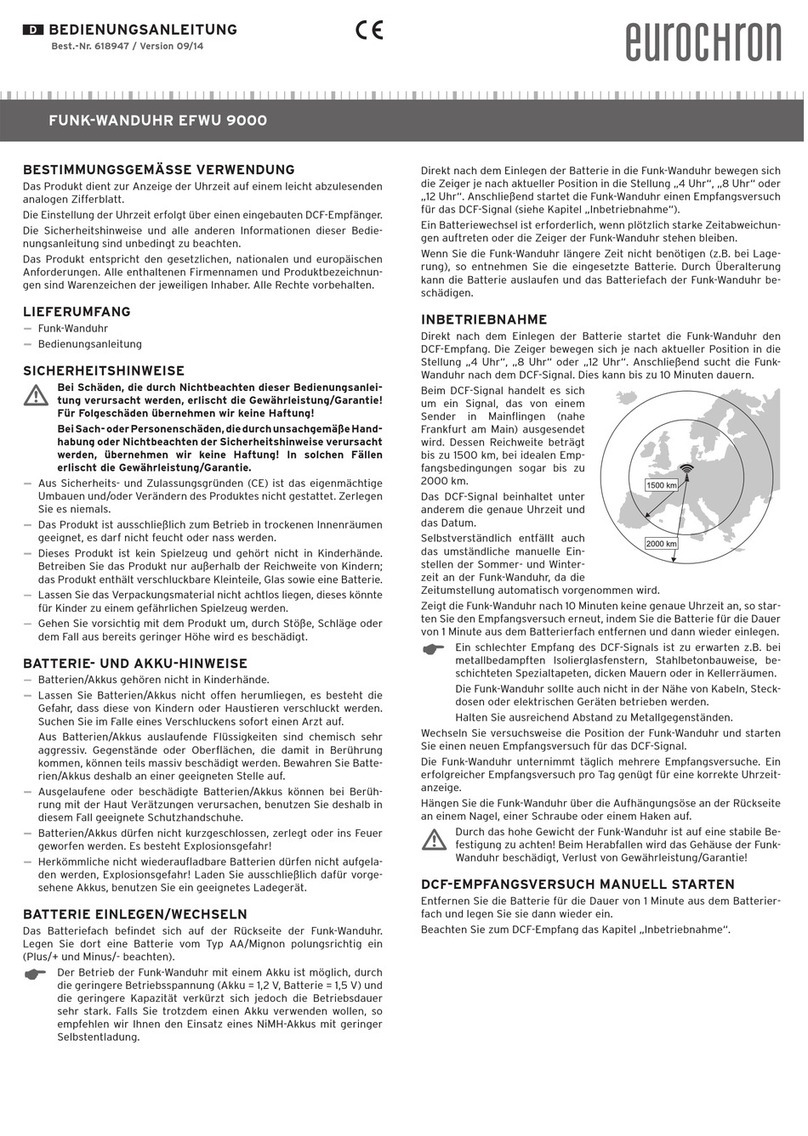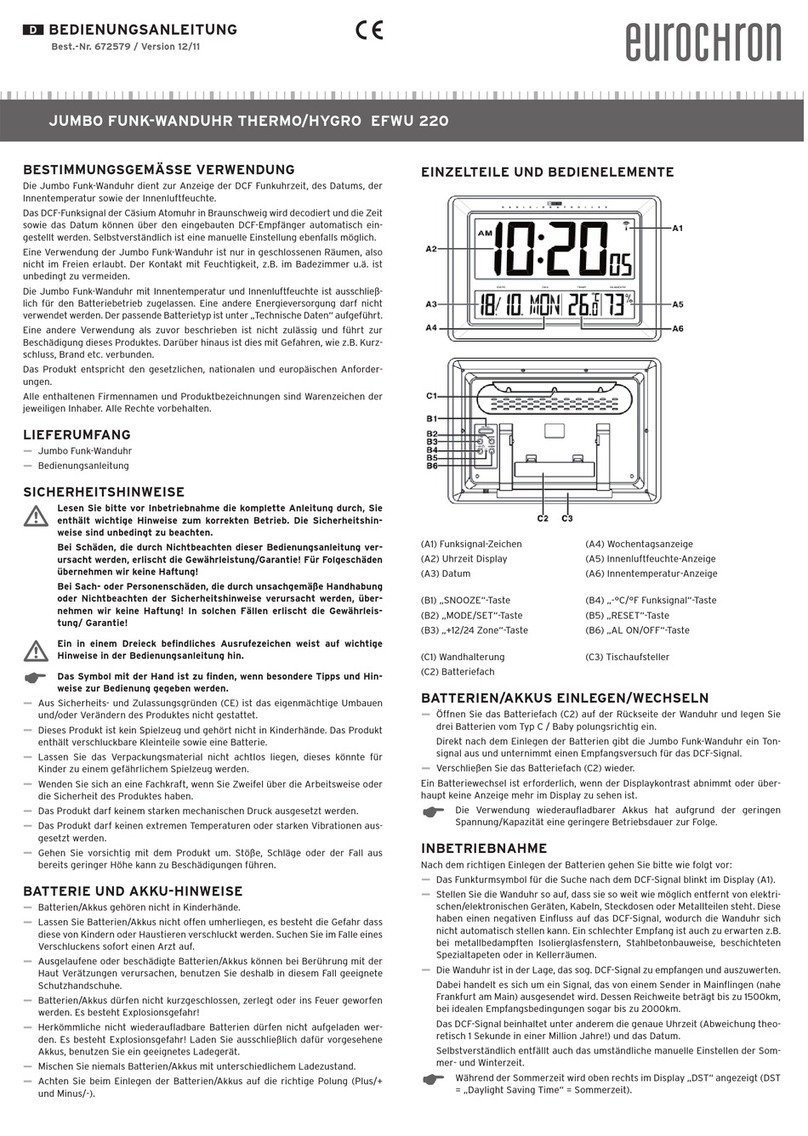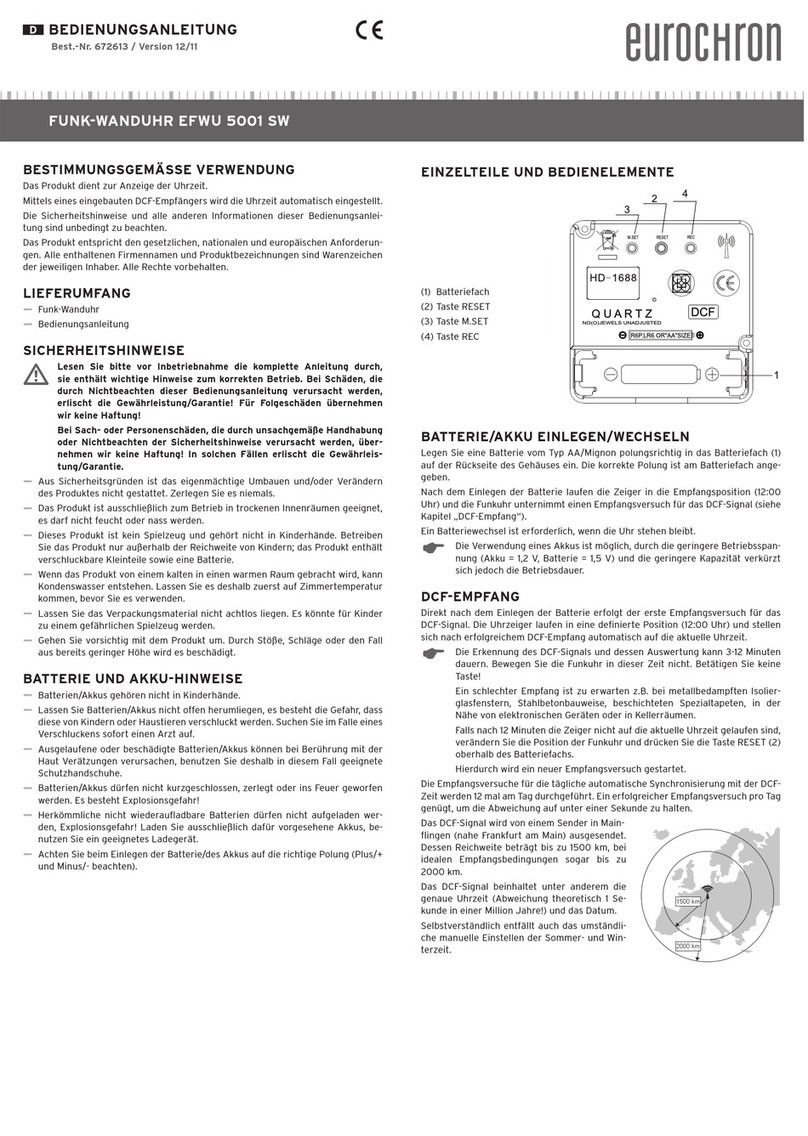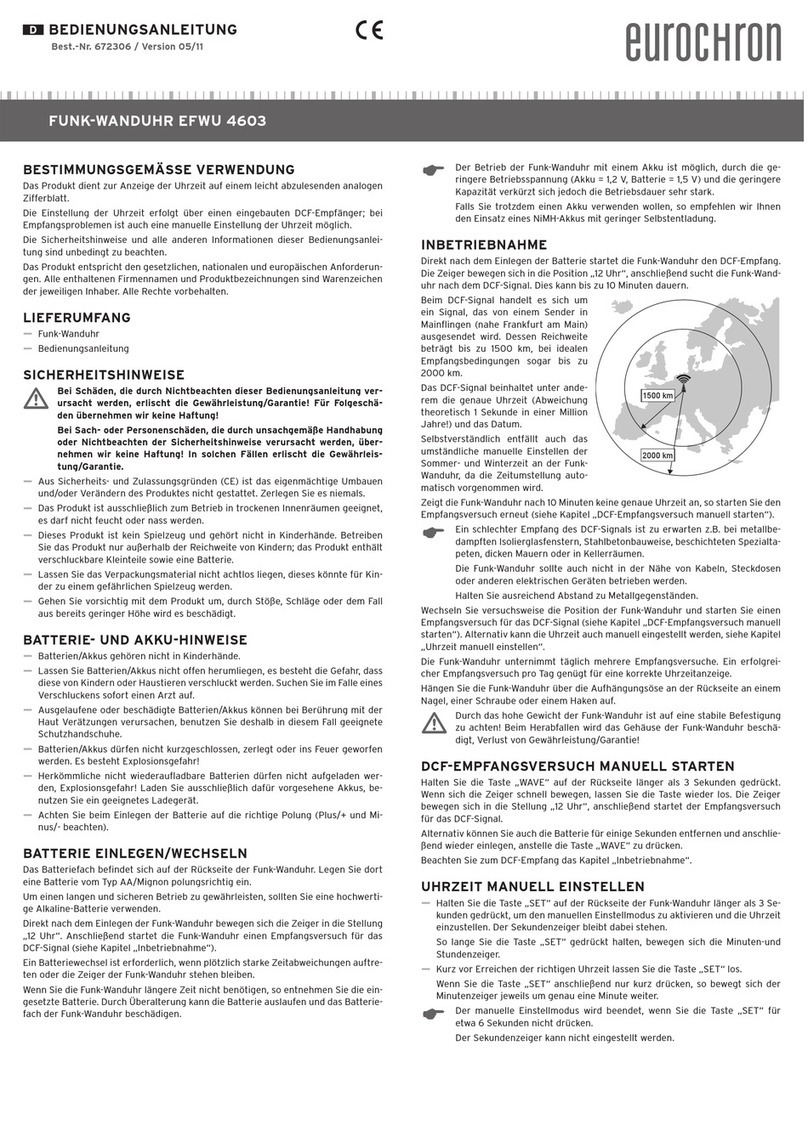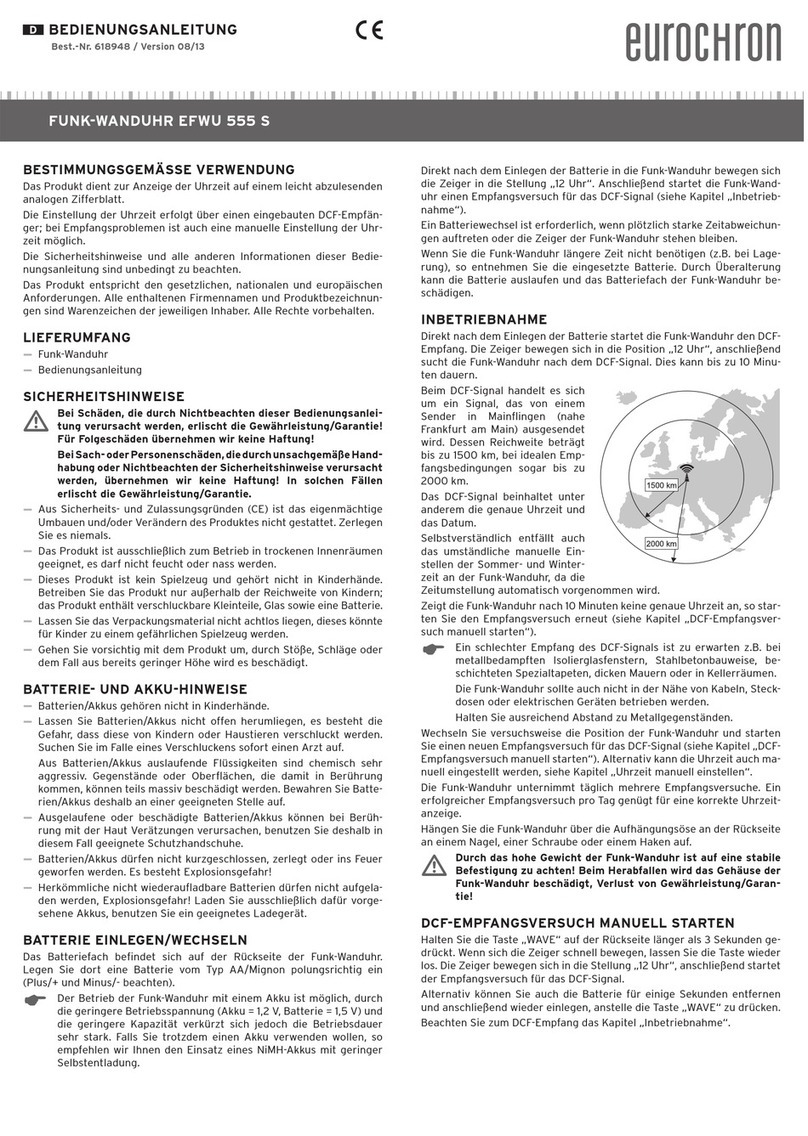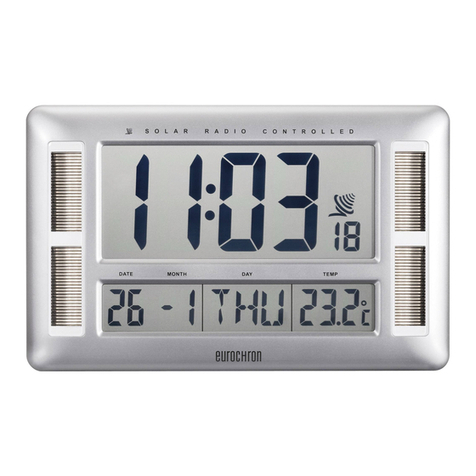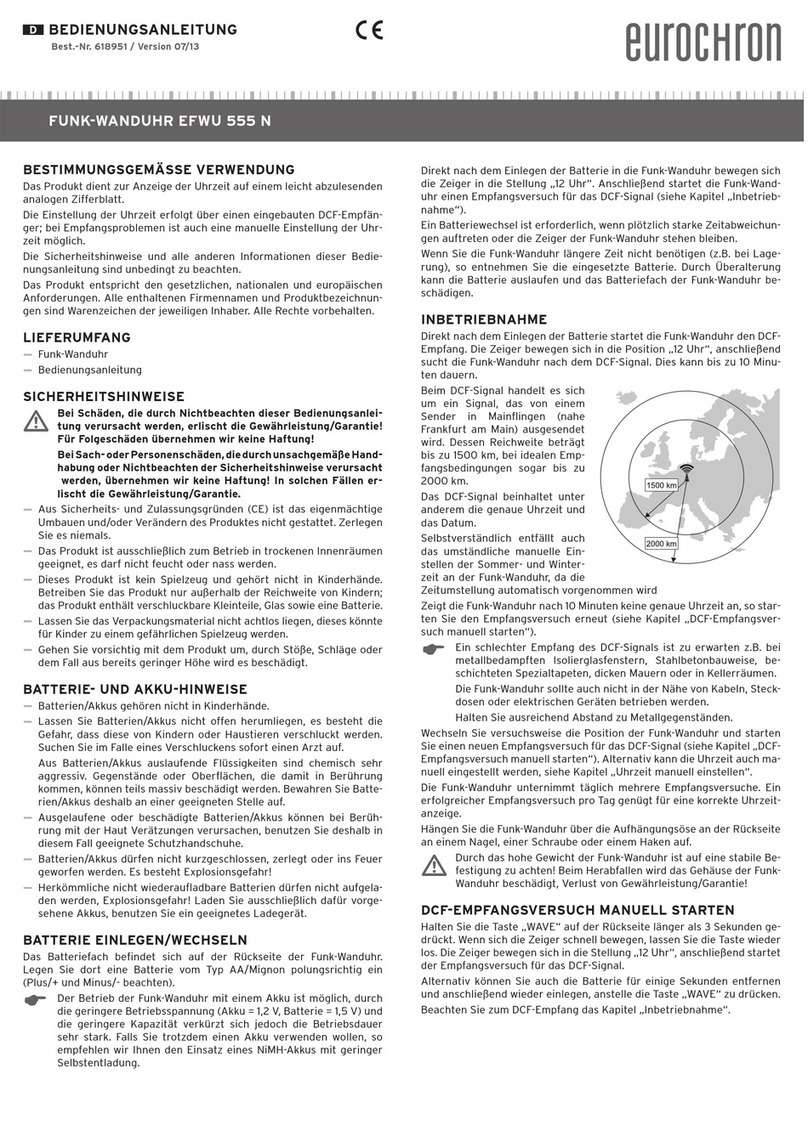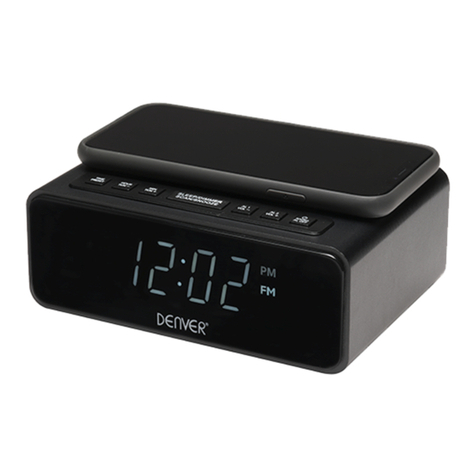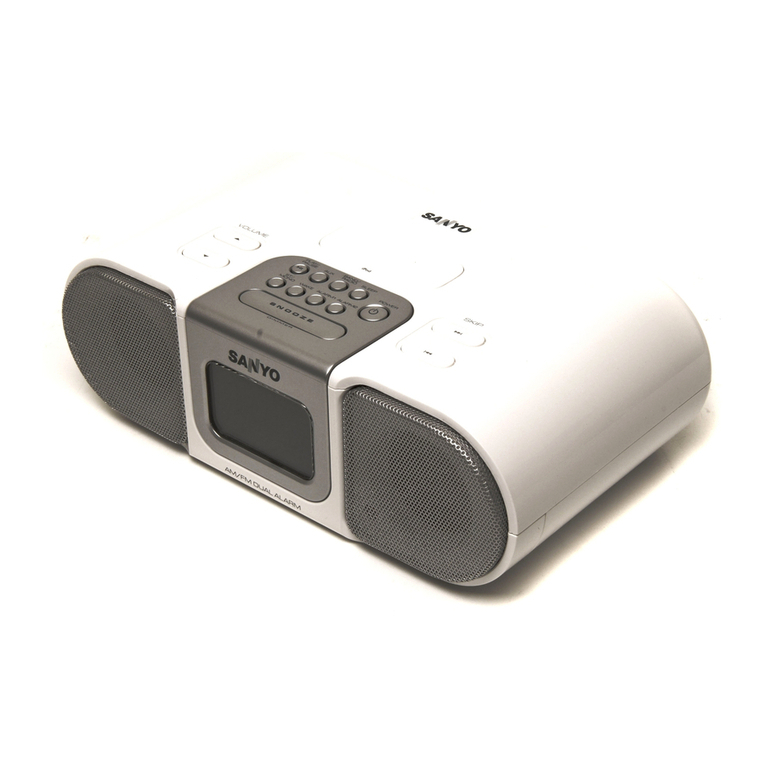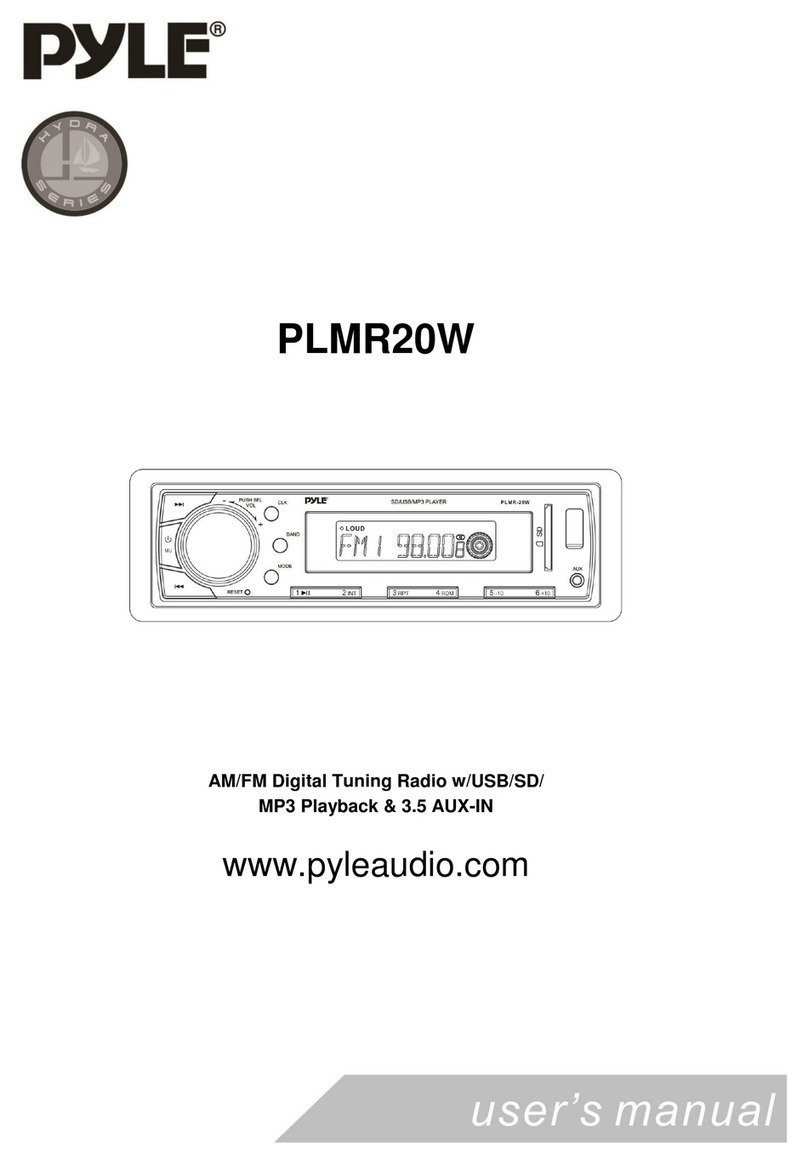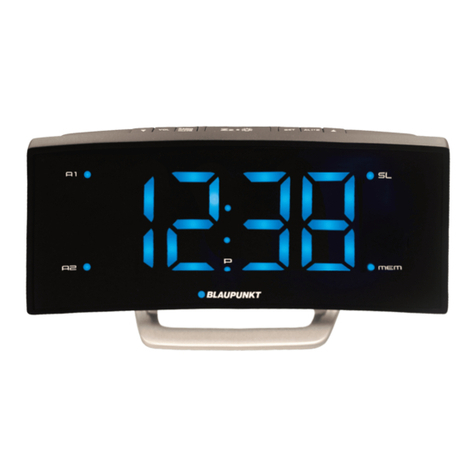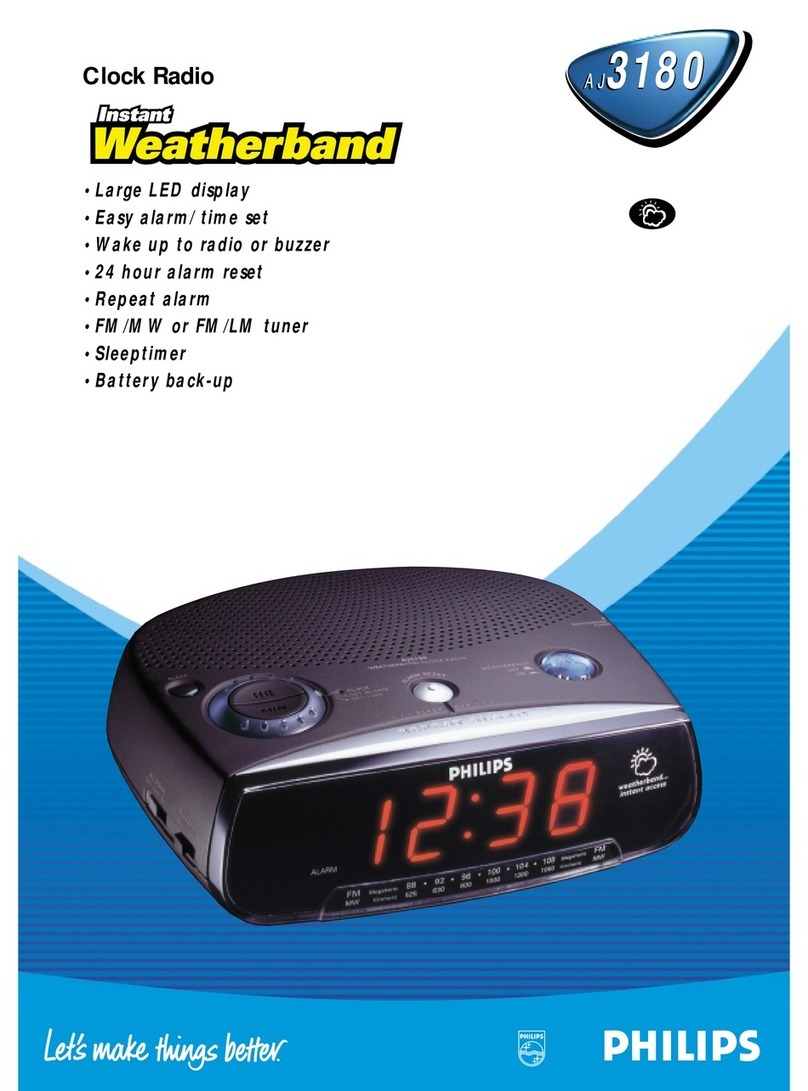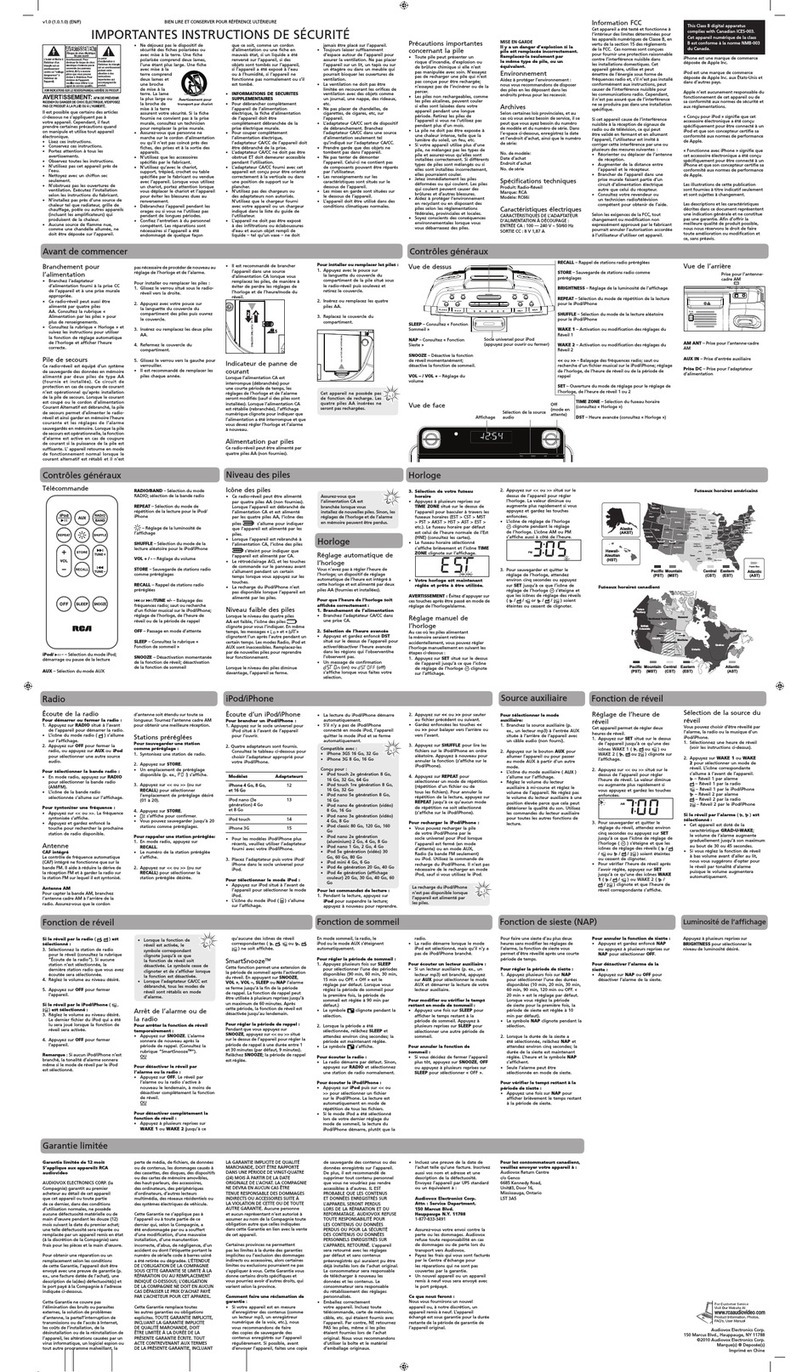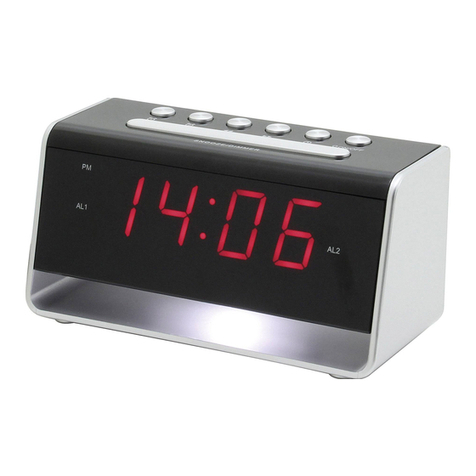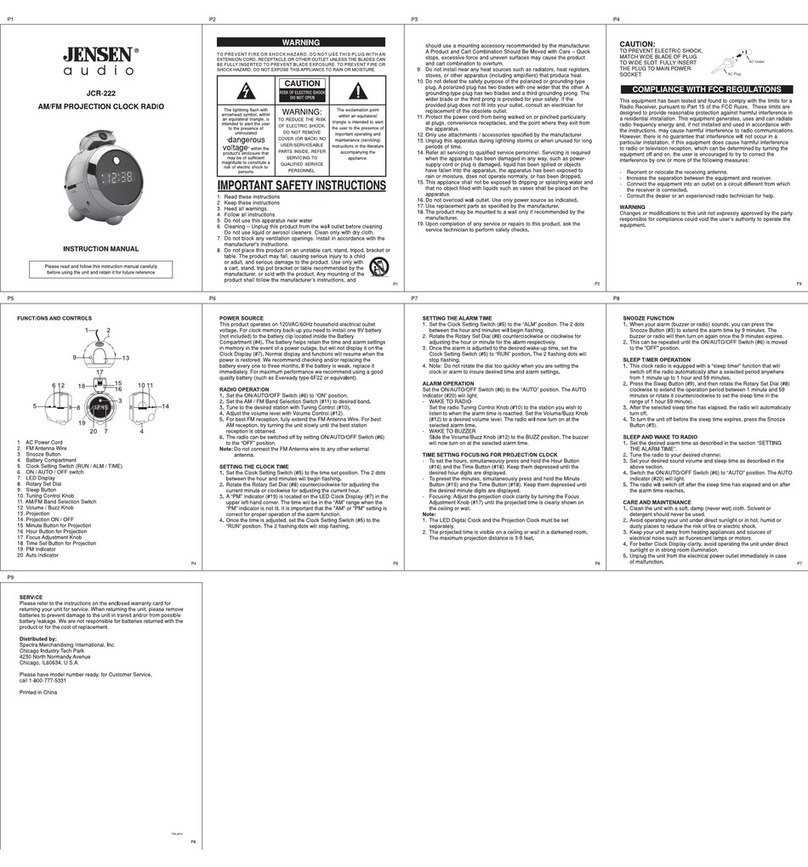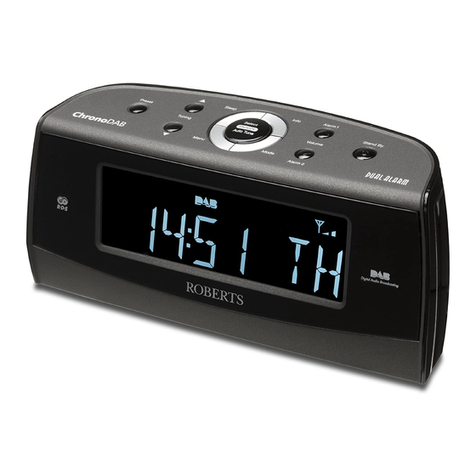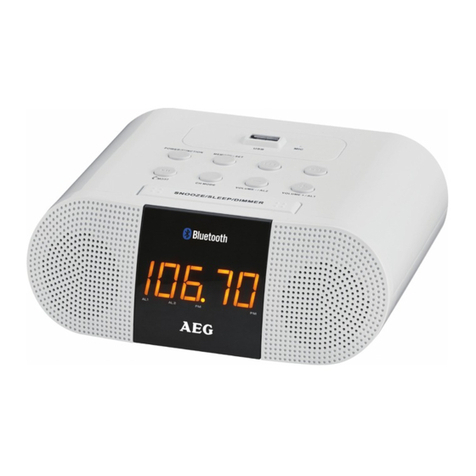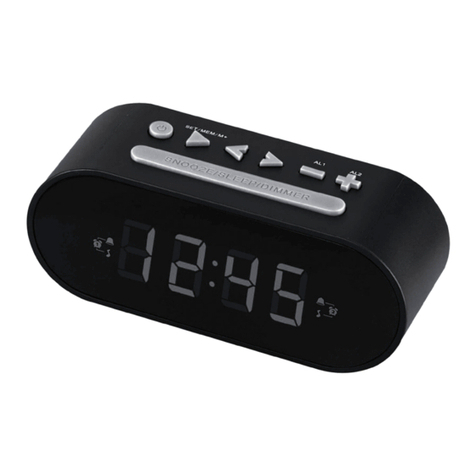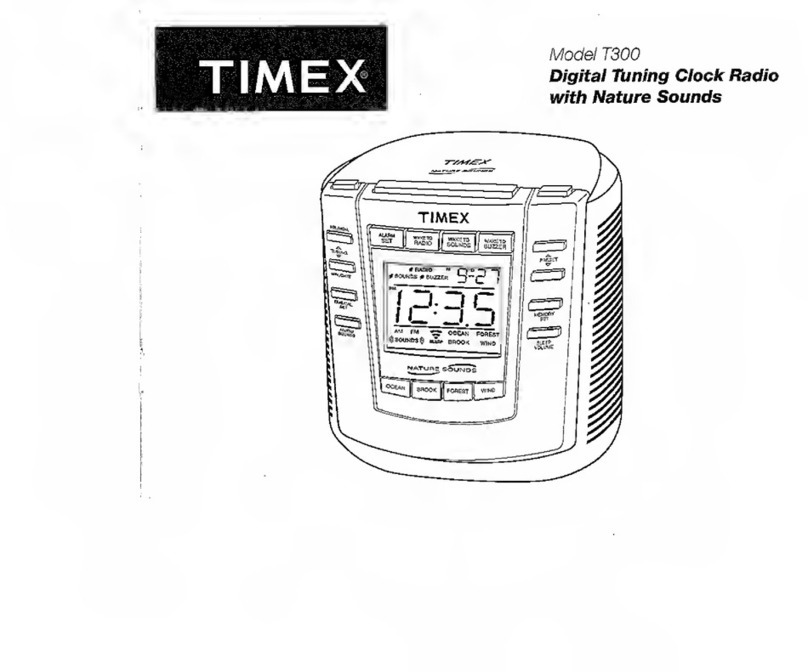
HORLOGE MURALE SPIEGELGLAS EUS 95
NOTICE D‘EMPLOI
N° de commande 672628 / Version 01/12
UTILISATION CONFORME
L’appareil sert à afficher l’heure, la date et la température intérieure.
Grâce à un récepteur DCF intégré, l’heure est réglée automatiquement.
Il faut impérativement respecter les consignes de sécurité et les autres informations
de ce manuel d’utilisation.
Cet appareil satisfait aux exigences légales nationales et européennes. Tous les
noms d’entreprises et les appellations d’appareils figurant dans ce mode d’emploi
sont des marques déposées de leurs propriétaires respectifs. Tous droits réservés.
CONTENU DE LA LIVRAISON
Mode d’emploi
CONSIGNES DE SÉCURITÉ
Lisez intégralement les instructions d’utilisation avant la mise en ser-
vice de l’appareil. Elles contiennent des consignes importantes pour son
bon fonctionnement. En cas de dommages dus au non-respect de ce ma-
nuel d’utilisation, la validité de la garantie sera annulée ! Nous déclinons
toute responsabilité pour les dommages consécutifs !
De même, nous n’assumons aucune responsabilité en cas de dommages
matériels ou corporels résultant d’une manipulation de l’appareil non
conforme aux spécifications ou du non-respect des présentes consignes
de sécurité ! Dans de tels cas, la garantie prend fin.
Pour des raisons de sécurité, toute transformation et/ ou modification de l’appa-
reil, réalisée à titre individuel, est interdite ! Ne jamais le démonter.
L’appareil convient uniquement à une utilisation dans des locaux secs et à l’inté-
rieur ; il ne doit pas être mouillé ou humide.
Cet appareil n’est pas un jouet, il ne doit pas être laissé à la portée des en-
fants. Utilisez cet appareil uniquement hors de la portée des enfants ; l’appareil
contient des petites pièces qui peuvent être avalées ainsi que des piles.
Lorsque vous transportez l’appareil d’une pièce froide à une pièce chaude, il est
possible que de la condensation se forme. Attendez d’abord que le produit ait
atteint la température ambiante avant de l´utiliser.
Ne pas laisser le matériel d’emballage sans surveillance, il pourrait constituer un
jouet dangereux pour les enfants.
Manier le produit avec précaution, des coups, des chocs ou une chute, même de
faible hauteur, peuvent l’endommager.
INDICATIONS AFFÉRENTES AUX PILES ET PILES
RECHARGEABLES
Les piles et les piles rechargeables ne doivent pas être laissées à la portée des
enfants.
Ne laissez pas traîner des piles ou piles rechargeables. Elles risquent d’être ava-
lées par des enfants ou des animaux domestiques. En pareil cas, consultez immé-
diatement un médecin.
Des piles/accus présentant des fuites ou des dommages peuvent brûler la peau,
pour cette raison, utilisez des gants de protection appropriés.
Ne court-circuitez pas les piles/ piles rechargeables. Ne les démontez pas et ne
les jetez pas au feu. Risque d’explosion !
Les piles normales non rechargeables ne doivent pas être rechargées. Risque
d’explosion ! Ne recharger que les accus prévus à cet effet, utiliser uniquement
un chargeur d‘accus approprié.
Respecter la polarité lors de la mise en place des piles/accumulateurs (respecter
les pôles positif/+ et négatif/-).
PIÈCES DÉTACHÉES ET ÉLÉMENTS DE COMMANDE
(1) Touche + (4) Touche RESET
(2) Touche SET/WAVE (5) Compartiment à piles
(3) Touche -
MISE EN PLACE ET REMPLACEMENT DES PILES/ACCUS
Dépliez le pied de support au dos du boîtier.
Ouvrez le compartiment à piles (5) et y insérer deux piles neuves de type AA/
Mignon en respectant la polarité. La polarité correcte est indiquée dans le com-
partiment à piles.
Refermez le compartiment à piles.
Le remplacement des piles est nécessaire lorsque le contraste de l’écran s’affai-
blit ou que l’écran ne fonctionne plus.
S’il n’y a aucun affichage à l’écran après insertion des piles, appuyez sur la
touche RESET (4) avec un objet pointu (par ex. avec un trombone déplié).
Si l‘écran n‘affiche toujours aucune image, cela signifie que les piles sont
déchargées. Veuillez alors remplacer la pile comme décrit ci-dessus.
Il est possible d’utiliser des accus. En raison de la faible tension de service
(pile rechargeable = 1,2 V, pile normale = 1,5 V) et de la faible capacité des
piles rechargeables, la durée de fonctionnement et la capacité seront ré-
duites.
PREMIÈRE MISE EN SERVICE
Immédiatement après la mise en place des piles, l’appareil effectue le premier
test de réception du signal DCF. L’icône de réception s’affiche à droite en bas de
l’écran et l’heure correcte est affichée en cas de réception réussie du signal DCF.
La détection du signal DCF et son analyse peuvent prendre quelques mi-
nutes. Ne pas déplacer la montre pendant ce temps. N´appuyez sur aucune
touche !
Les fenêtres isolantes en métal, les murs en béton armé, les revêtements
spéciaux de papier peint, les appareils électriques à proximité ou l’installa-
tion dans une cave peuvent aussi altérer la réception.
Si l’heure actuelle ne s’affiche pas au bout de 10 minutes, déplacez l’horloge
et recommencez une tentative de réception manuelle du signal radio (voir
chapitre suivant).
Cela va démarrer une nouvelle recherche de réception.
La recherche de réception pour la synchronisation automatique quotidienne avec
l’heure DCF peut être réalisée plusieurs fois par jour. Une seule réception par jour
suffit à maintenir l’écart au dessous de 1 seconde.
Le signal DCF est émis à partir d’un émetteur si-
tué à Mainflingen (à proximité de Francfort-sur-
le-Main) Sa portée est d´environ 1500km, voire
même de 2000km dans des conditions de récep-
tion idéales.
Le signal radio DCF comprend entre autres l’heure
exacte (écart théorique d’une (1) seconde sur un
million d’années !) et la date.
Bien entendu, cela élimine aussi les tracas du ré-
glage manuel des heures d’hiver et d´été.
